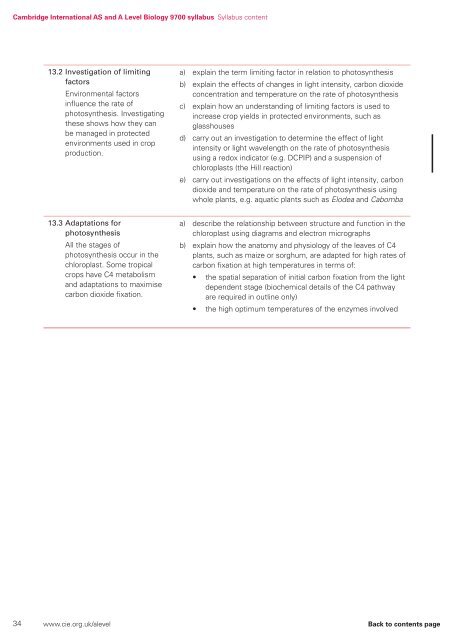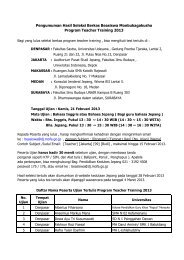9700_y16_sy
9700_y16_sy
9700_y16_sy
Create successful ePaper yourself
Turn your PDF publications into a flip-book with our unique Google optimized e-Paper software.
Cambridge International AS and A Level Biology <strong>9700</strong> <strong>sy</strong>llabus Syllabus content<br />
13.2 Investigation of limiting<br />
factors<br />
Environmental factors<br />
influence the rate of<br />
photo<strong>sy</strong>nthesis. Investigating<br />
these shows how they can<br />
be managed in protected<br />
environments used in crop<br />
production.<br />
a) explain the term limiting factor in relation to photo<strong>sy</strong>nthesis<br />
b) explain the effects of changes in light intensity, carbon dioxide<br />
concentration and temperature on the rate of photo<strong>sy</strong>nthesis<br />
c) explain how an understanding of limiting factors is used to<br />
increase crop yields in protected environments, such as<br />
glasshouses<br />
d) carry out an investigation to determine the effect of light<br />
intensity or light wavelength on the rate of photo<strong>sy</strong>nthesis<br />
using a redox indicator (e.g. DCPIP) and a suspension of<br />
chloroplasts (the Hill reaction)<br />
e) carry out investigations on the effects of light intensity, carbon<br />
dioxide and temperature on the rate of photo<strong>sy</strong>nthesis using<br />
whole plants, e.g. aquatic plants such as Elodea and Cabomba<br />
13.3 Adaptations for<br />
photo<strong>sy</strong>nthesis<br />
All the stages of<br />
photo<strong>sy</strong>nthesis occur in the<br />
chloroplast. Some tropical<br />
crops have C4 metabolism<br />
and adaptations to maximise<br />
carbon dioxide fixation.<br />
a) describe the relationship between structure and function in the<br />
chloroplast using diagrams and electron micrographs<br />
b) explain how the anatomy and physiology of the leaves of C4<br />
plants, such as maize or sorghum, are adapted for high rates of<br />
carbon fixation at high temperatures in terms of:<br />
• the spatial separation of initial carbon fixation from the light<br />
dependent stage (biochemical details of the C4 pathway<br />
are required in outline only)<br />
• the high optimum temperatures of the enzymes involved<br />
34 www.cie.org.uk/alevel Back to contents page





